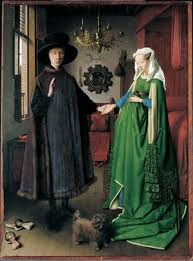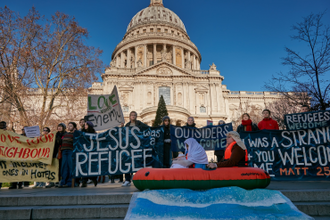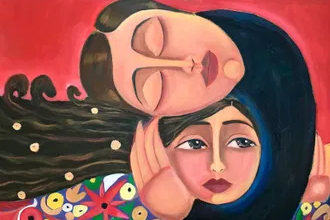National Gallery - Van Eyck and the Pre Raphaelites

Arnolfini portrait - Van Eyck
The National Gallery has done it again! It has pulled off a remarkable coup of collaboration with the Tate to present an exhibition which joins the dots historically and artistically between Van Eyck and the Pre Raphaelite Brotherhood.
The artists, Rosetti, Millais and Holman Hunt were nineteenth century students at the Royal Academy. They made the short walk across to the Gallery from lectures and found their inspiration in the Arnolfini portrait by of 1434.
It is this painting which is the focal point of the exhibition since it was the catalyst for the new approach by the three student artists in the 1840s.
The portrait is the centre point and hung lower than usual so that the viewer is drawn in at a more natural height and can more readily see the detail in the convex mirror, the backs of the subjects and particularly two visitors in the open doorway. Around the mirror are minute panels depicting the Passion of Christ. The brush strokes leave no trace of the human hand. The date of the painting, 1434, is exactly recorded most unusually in the middle of the work, almost like graffiti, defiantly not in the discreet bottom right hand corner, declaiming Jan Van Eyck is here! The man, Arnolfini, is real, pale and interesting simply because Van Eyck presents him as actually is.
The style of painting the Brotherhood was encouraged and expected to follow was the work of established artists such as Rubens.
However, the Pre Raphaelites decided to pursue a different path, a return to naturalism and the world as it seemed. But, they were perceived to be part of a covert Catholic group and regarded with suspicion if not derision at the time, a view which persisted well into the twentieth century.
In his day, Millais was a highly successful, superb technician. He became President of the Royal Academy, a position Rosetti and Hunt saw as selling out.
Their use of convex mirrors in the works is a repetitive key element, almost like a camera lens offering the viewer evidence of their technical precision.
Holman Hunt in his Awakening Conscience explores a moral maze, will the courtesan be saved or won't she? She can see something we can't. What is it?
The artists developed a visual conversation between each other. It later included William Morris who was interested in other areas such as textiles and design in the home, along side a bohemian rejection of mass produced goods of Victorian era.
In the 1860s their work explored dream and fantasy themes. The dark mirror becomes a fixture. Rosetti had over twenty mirrors in his Chelsea home.
Van Eyck inspired the artists to look afresh at the real world and later beyond reality, exploring the vacuity of space, techniques, composition, and the transience of human life applied to the age and times in which they lived.
The exhibition is curated with a particular compelling narrative and gives a fresh insight to the nineteenth century bad boys of art.
Reflections: Van Eyck and the Pre-Raphaelites
2nd October 2017 - 2nd April 2018
Sunley Room
Admission Charge
National Gallery
Trafalgar Square, London
For more information see: www.nationalgallery.org.uk/whats-on/exhibitions/reflections-van-eyck-and-the-pre-raphaelites
See also Dr Philip Crispin's review for ICN: www.indcatholicnews.com/news/33630


















